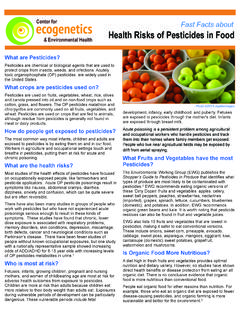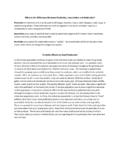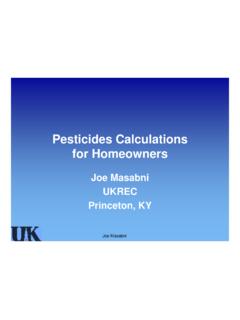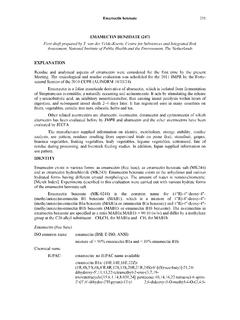Transcription of Working with pesticides - HSE
1 70 Working with This part of the code provides guidance on: how to handle, transport and prepare pesticides for use; how to use them safely; and what action to take after using Preparing to apply pesticidesPhotograph Crown Copyright, courtesy of the Central Science LaboratorySection Checks to carry outIt is important to carry out a series of checks before using any pesticide and regularly during thetreatment season, as appropriate. Make sure that you have taken the following action. 3 Had suitable training and, if necessary, gained a certificate of competence to apply the pesticide inthe proposed and understood the product label and any extra information relating to off-label a suitable and sufficient COSHH assessment, recorded it and checked that it is still in place any measures to control exposure, and keep these measures up to date.
2 Suitable PPEis out an appropriate environmental risk assessment and made sure that you can keep to anymeasures to protect wildlife and the environment, such as any buffer zones or other restrictions onuse, to protect: aquatic life (including any LERAP conditions); bees and other insects and creatures; and surface water and account of the need to avoid contaminating feed stores or areas that livestock have access measures to meet any conditions on the label for keeping livestock or people out of treatedareas for a certain period.
3 3 Got advice and, when necessary, received permission from the appropriate agencies, before usingpesticides in areas of special environmental status in or near water, from aircraft and, wherenecessary, on public rights of way. 3 Given adequate notice to occupiers of neighbouring properties and members of the public. Displayed warning notices. Followed the specific responsibilities for giving notice when spraying from the air and whenspraying sulphuric acid. Given adequate notice to equipment for applying pesticide to make sure it is in good Working order and is workingcorrectly and emergency procedures in place and make sure operators have: appropriate emergency equipment such as spill kit and decontamination equipment for skin and eyes; emergency details for the products being used.
4 And a list of emergency contact details for the environment agencies and medical sure the pesticide can be transported safely and legally to the area you are enough of the correct pesticide to complete the job, and checked the calculations of the amountof pesticide needed for each tank, load or run, possibly allowing for an untreated or under-dosedarea for disposing of sprayer appropriate arrangements for cleaning equipment and disposing of any waste pesticide andpesticide packaging (such as containers, closures and foil seals) safely and legally.
5 Working with Dangerous practicesThe following activities are dangerous when pesticides are being used. They should be forbiddenbyemployers and never practised by anyone using pesticides . Sucking or blowing (by mouth) any nozzle, pipe connection or device which forms part ofthe equipment for applying pesticide. Continuing to work after being contaminated. (You should immediately remove allcontaminated items of clothing, wash the affected skin and put on clean clothing beforestarting again.)You should also make sure that you do not eat, drink, smoke or go to the toilet while workingwith pesticides .
6 You should carry out these activities outside the treated area, after you haveremoved your PPE and washed your hands and Handling pesticide containers Read the product label before opening any pesticide container. Make sure that you follow theprecautions shown on the product label and work in line with any instructions given on the labelor in the relevant notices of approval. Even when the product label does not say you need to wear PPE, it is good practice for you towear basic PPE (such as overalls, suitable protective gloves and boots) at all times when handlingpesticides or their pesticides should be handled in a well-ventilated area to avoid any possible build-up ofvapours.
7 Avoid sparks and naked flames as some pesticides may present a fire risk. Theseproducts will be labelled with the appropriate hazard symbol and risk phrase. If pesticide containers are damaged, you will need to take extra precautions. Wear the PPE stated on the product label or, if this section of the label cannot be read, theappropriate PPE specified in annex G and also that specified on the MSDS. Immediately contain any spillage and dispose of any contaminated material safely and you cannot safely use the contents immediately, either put the damaged container with itscontents in another suitable container or transfer the contents to an undamaged container whichhas held the same product.
8 Whichever alternative you choose, the container must be clearlylabelled with the name of the pesticide, information on possible dangers and the precautions tobe taken. Where possible, use original labels. Your supplier should be able to help with this oryou may be able to get a label from the manufacturer s use an empty food or drink container to hold a you handle flammable products you should read and understand HSE Guidance bookletHS (G) 51 The storage of flammable liquids in containers .Section 473 Take care when moving pesticide containers in and out of the store and never leave pesticidecontainers unattended unless they are in a secure Transporting pesticides The lawThis section gives guidance on how to transport pesticides safely and meet the laws relating tocarrying dangerous goods (see annex A).
9 Most of the legal conditions only apply above certainamounts which depend on how the goods are being transported (for example, in packages, intanks or in bulk) as well as on their transport category which may be given in The Carriage ofDangerous Goods and Use of Transportable Pressure Equipment Regulations 2004 (see annex A).Agricultural pesticides (see annex C) or plant-protection products (but not sulphuric acid) do nothave to meet some of these legal conditions as long as they: have been approved under the Control of pesticides Regulations 1986 (as amended) orunder the Plant Protection Products Regulations 2005; are transported in or on an agricultural vehicle (see annex C) or any associated trailer; are diluted ready for use, or supplied in a ready-to-use form.
10 And are being carried from one piece of agricultural land to another within a 50-kilometre transporting pesticide (especially on farms and holdings) will usually meet theseconditions, users collecting pesticides from their suppliers or transporting pesticides from theirstore to other locations (such as contractors, especially in amenity and forestry areas) may not(depending on the type of vehicle being used and the amount of pesticide being transported).Even if the exemptions above apply, you may still have to meet other conditions applying totransporting dangerous goods, such as the suitability of vehicles and containers for certaindangerous goods.













